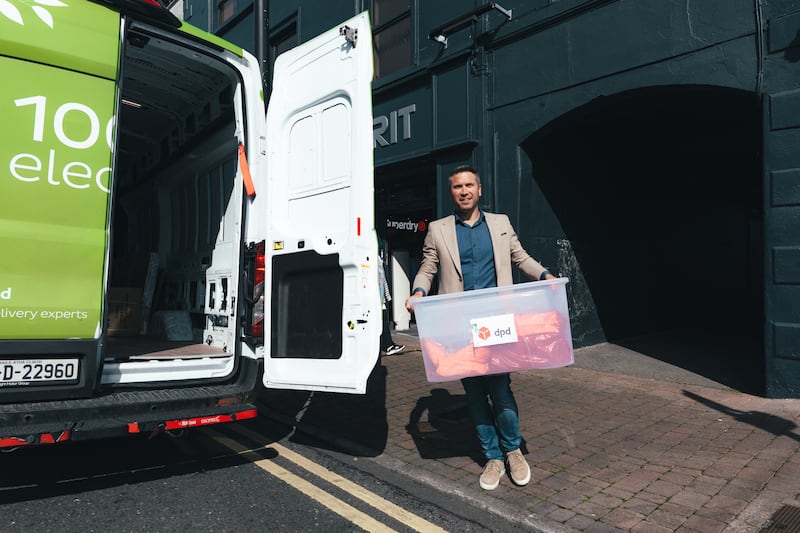When clothing retailer Peter Dolan discovered generative AI last year he was, like so many, mesmerised by the novelty of asking a computer questions and getting conversational answers.
Dolan is the co-owner of Spirit Clothing in Longford. As befits someone who has both a bricks-and-mortar store and a successful ecommerce business, he’s prsetty adept at technology. He quickly moved from playing with ChatGPT’s version of generative AI (GenAI) to asking it to suggest new ways of managing stock.

Previously he had to manually input 15 different fields of information for each garment received – details such as colour, size, cost and sale price. He had to do this every time a new order arrived, for up to 100 garments at a time. At five minutes a pop, it took hours.
“I asked ChatGPT, how I can make this process faster? Because of what it suggested I now only have to press one button to populate the whole system, both for internal use and for online sales. What used to take me five minutes per item now takes me just five seconds,” says Dolan.
READ MORE
Even businesses that were already working on artificial intelligence see GenAI as a step change. Carelon Global Solutions’ team of software developers, data scientists and systems analysts in Limerick are working to streamline healthcare operations.
“We are creating AI products for health, supporting our clients to provide predictive and preventive healthcare,” explains country head John Shaw.
“We are also using GenAI, including for an internal project looking at our own productivity. The power of it is extraordinary, which is why, when ChatGPT launched, it had the fastest adoption rate of all. In fact the enabling technologies behind it had been around for years. What changed was that the price crashed down. What was previously so expensive that only large companies could afford it is suddenly in everyone’s pocket.”
Sema Software specialises in uncovering legal and regulatory risk in software, working with investors to gauge the health of a business’s coding in advance of mergers, acquisitions or investments.
“We provide a report, kind of like getting a report on your car,” explains Brendan Cody-Kenny, its co-founder and chief scientist.
Increasingly its work includes AI detection. “It’s about finding out how much AI is being used in your codebase. We go inside the ‘black box’ which might be made up of a million lines of code, written by 100 different people, over the past 10 years, as part of a client’s technical due diligence,” he says.
Whereas traditionally this kind of work was done by hiring a software consultant to plough through the codebase, line by line, Sema Software automates the process.
But even for a company as tech savvy as Sema, GenAI represents a shift. “Right now everybody wants to get the productivity gains that GenAI can power, but they also want to know the risks,” says Cody-Kenny.
Sema has a new product, AI Code Monitor, to allow clients to see how developers are using GenAI across their codebase and assess the legal and regulatory risk attached.
“If something is purely written by AI you might not be able to get copyright for your code. Also, if developers are copying and pasting stuff you have to assess how fit for purpose it really is. It’s a bit like doing a university thesis and putting in some paragraphs from ChatGPT – it might not flow,” he explains.
The other question to be assessed is how secure it is, not to mention how correct. GenAI has been known to “hallucinate” in the answers it gives. AI created code can be similarly glitchy.
Despite such concerns, GenAI is a technology about which Cody-Kenny is excited. “The potential for productivity gains is massive. It’s like everyone in your development team suddenly has their own intern. You’re not doubling capacity but you are giving each of them 50 per cent extra,” he says.
He personally uses it for thought experiments and as a sounding board. “Many times I’ll say to the GenAI system, here’s some XML I want it in CSV – write some code that will do that. It’s very good at tasks but currently if you ask it to do anything too complicated, it doesn’t get there. However, within a year, you might well be able to give it access to your entire codebase. That will, of course, be a risk, but it will have the context that it is currently missing,” he explains.
“It won’t be long before you could tell the GenAI that you want your code to be faster, then head off for the weekend while it chugs away, while it has the access to modify and test the code, and get it done. At that stage the only limit will be the size of your credit card.”
It has already proven itself as a point solution, one that is better than Google, and use will soon move from task setting to goal setting, Cody-Kenny predicts. “Everybody is trying to get it plugged into context now, to add it to workflows,” he says.
The risk of data leaks is something regulators are worried about, Cody-Kenny believes. The EU’s forthcoming AI Act will help but the pace of proliferation is putting regulators under pressure to keep up. “To be fair, they are moving faster than I’ve ever seen before,” he says.
You’re not going to lose your job to AI but you are going to lose your job to the guy using AI
— Fergal Geraghty, Data Value Hub
Part of the reason for that proliferation is that GenAI transforms the way humans and technology interact.
“We are going to just talk to computers the way we talk to one another,” says Fergal Geraghty, CEO of the Data Value Hub, which helps businesses to unlock the full potential of their data.
AI means that instead of poring over spreadsheets we can simply prompt analysis. Any industry that uses manual processes against data to generate a result, such as accountancy, could be transformed, Geraghty believes.
“You’re not going to lose your job to AI but you are going to lose your job to the guy using AI,” he says.
That speaks to a particular challenge. To benefit from GenAI, you already have to have data-gathering digital systems and processes in place. However, too few small businesses in Ireland do.

“AI is coming on very strong but for most small companies today, talking about AI deployment is like wanting to be fluent in a foreign language, having not put the work in. If you are not digital, you cannot really talk about AI in your business,” cautions John O’Shanahan of LeanBPI, a digital transformation consultancy.
“The real benefits will be in how companies use AI to give them an edge over competitors. For example, If all content writers are using ChatGPT, it would be hard enough to differentiate between the average and the great. In the early days it’s an advantage just to use ChatGPT but that won’t last long.
“For longer-term advantages, small businesses need to look at what innovative ideas they can come up with in the business to use AI. Where your application or idea is combining with AI capability, that’s not easy to copy.”
Dean Carroll, creative director of Simply Social, a social media creative agency, was quick to see the potential of GenAI, but only in a limited capacity. For example, the firm uses image-based GenAI tools to quickly create images used for story boards or for when presenting a pitch.
“Previously we’d have had to spend time searching the internet for the kind of images we needed to get an idea across to a client. Now we can get basic images very fast,” he explains.
AI-powered audio apps help take down unwanted background noises, such as traffic, which had to be done manually before.
“It is not losing anyone their job but it is buying us more time,” says Carroll. “It’s like drive assist for a truck driver, another tool for our toolkit.”
To date, image generators haven’t been great at putting branded product into their images, he points out. But that will change.
“In the next year I’d expect we’ll see another leap forward but the better they get, the more of a threat they are to my job,” says Carroll. “It almost sounds dystopian to say it but at some stage governments might have to step in with regulation to say, this is as far as we want this to go with this.”















